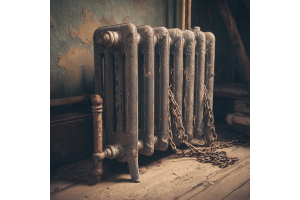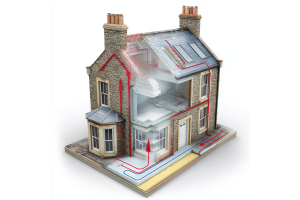
As sustainability continues to shape consumer decisions, more UK homeowners and businesses are asking: Are electric radiators environmentally friendly? At Geyser, we understand the importance of reducing your carbon footprint without compromising on comfort. This article explores the environmental credentials of electric radiators, including how they compare to traditional heating systems and how you can maximise their efficiency.
What Are Electric Radiators?
Electric radiators are standalone heating units that use electricity to generate heat and distribute it into a room. Unlike traditional central heating systems that rely on a network of pipes and a boiler to heat water, electric radiators operate independently, providing a modern, efficient, and increasingly popular alternative for residential and commercial properties.
Let’s break this down in detail:
How Do Electric Radiators Work?
At the core, electric radiators function by converting electrical energy directly into heat using internal heating elements. This heat is then transferred to the outer body of the radiator and released into the room via radiation and convection.
There are three main types of electric radiator technology:
1. Dry Thermal (Convection-Based) Radiators
-
Use metallic heating elements (usually aluminium or steel) that heat up quickly.
-
Ideal for rooms that need to heat up fast.
-
Lightweight and easy to install.
-
Examples: Slimline or minimalist panel radiators.
2. Oil-Filled Radiators
-
Contain a sealed reservoir of thermally conductive oil that is heated by internal elements.
-
The oil retains heat even after the unit is turned off, offering longer-lasting warmth.
-
Excellent for consistent heating over extended periods.
-
Common in traditional-style radiators with column designs.
3. Ceramic Core Radiators
-
Use a ceramic or stone-like material to absorb and release heat slowly and evenly.
-
Known for excellent heat retention and uniform room temperatures.
-
Usually paired with sophisticated digital thermostats for precision control.
What Makes Electric Radiators Different from Other Electric Heaters?
It’s important not to confuse electric radiators with electric fan heaters, bar heaters, or infrared panels, which have different heating profiles and use cases.
| Feature | Electric Radiators | Fan Heaters | Infrared Panels |
|---|---|---|---|
| Heating Type | Radiant + Convection | Forced air | Radiant only |
| Noise Level | Silent | Noisy (fan) | Silent |
| Heat Retention | High (esp. oil/ceramic) | Low | Low |
| Usage | Whole-room heating | Spot heating | Spot heating |
| Thermostat Integration | Yes | Often no | Limited |
Electric radiators are designed for whole-room, long-term heating, with better insulation, safety features, and control options than most plug-in alternatives.
Sizes, Styles & Installation Options
Electric radiators come in a wide variety of styles, making them suitable for every room type and interior design:
➤ Wall-Mounted
-
Most popular format.
-
Space-saving, ideal for fixed heating zones.
-
Can be hardwired or plugged in depending on model and installation.
➤ Freestanding / Portable
-
Great for flexible placement or temporary setups.
-
Typically feature castors or feet for mobility.
➤ Towel Radiators (Bathroom Use)
-
Designed specifically for bathrooms.
-
Dual function: heats the room and dries towels.
-
IP-rated models for safety in wet areas.
➤ Designer Radiators
-
Available in vertical, horizontal, curved, and sculptural forms.
-
Aesthetic focus without sacrificing efficiency.
-
Geyser offers a curated collection of modern designer electric radiators.
Power and Output: Understanding Wattage
When choosing an electric radiator, understanding power output is crucial. Power is measured in watts (W), and the right wattage depends on:
-
Room size
-
Insulation quality
-
Number of external walls/windows
As a general rule of thumb:
-
Small rooms (e.g. bathroom, box room): 500W – 750W
-
Medium rooms (e.g. bedroom): 1000W – 1500W
-
Large rooms (e.g. lounge): 1500W – 2500W
Geyser offers a BTU/Wattage Calculator on-site to help you size your radiator accurately for maximum efficiency and comfort.
Smart Technology & Controls
Today’s electric radiators often come with smart controls, including:
-
Digital thermostats (for precise temperature control)
-
Weekly timers (customise heating schedules)
-
Open window detection (auto shut-off when heat is wasted)
-
WiFi and app control (remote management via smartphone or smart home systems)
These features contribute directly to reducing wasted energy, increasing user comfort, and lowering electricity bills.
Safety & Compliance
All reputable electric radiators (including those from Geyser) are:
-
CE-certified and RoHS compliant
-
Protected with thermal cut-off switches to prevent overheating
-
Often IP-rated for safe use in bathrooms
-
Made with fire-retardant materials and sealed elements
Summary: What Makes Electric Radiators Unique?
| Feature | Benefit |
|---|---|
| Direct electricity-to-heat conversion | 100% efficiency at point of use |
| Independent operation | No need for a boiler or pipework |
| Multiple types (oil, dry, ceramic) | Tailored heat performance |
| Smart control options | Lower bills and better comfort |
| Stylish and varied designs | Seamlessly integrate into your home décor |
| Green potential | Especially when powered by renewable electricity |
How Do Electric Radiators Impact the Environment?
Electric radiators are widely regarded as one of the most environmentally conscious heating choices—especially when powered by clean electricity. But to fully understand their environmental impact, we must consider several key factors:
1. Zero Emissions at Point of Use
One of the biggest environmental advantages of electric radiators is that they produce zero direct emissions. This means:
-
No combustion of fossil fuels
-
No release of carbon monoxide (CO) or carbon dioxide (CO₂)
-
No nitrogen oxides (NOx), particulate matter, or sulphur dioxide (SO₂)—all of which contribute to indoor air pollution and respiratory issues
In contrast, gas and oil boilers emit over 2 tonnes of CO₂ per household per year on average in the UK. Electric radiators completely eliminate these on-site emissions, making them a clean choice for both indoor air quality and outdoor pollution reduction.
2. 100% Efficiency at Point of Use
Electric radiators convert 100% of the electrical energy they consume into heat. That means:
-
No energy is lost through flue gases (as in gas boilers)
-
No heat is lost in pipework or through hot water storage tanks
-
You get direct, immediate, and full use of the energy you pay for
This level of efficiency translates to lower wastage, better performance in insulated homes, and a reduced carbon footprint when powered responsibly.
3. Greening of the UK Grid
The sustainability of electric heating depends heavily on how the electricity is generated. Fortunately, the UK has made remarkable progress in decarbonising its electricity grid:
-
In 2024, over 50% of electricity in the UK was generated from renewable and low-carbon sources, including wind, solar, hydro, and nuclear.
-
By 2035, the UK government plans for a fully decarbonised electricity grid.
This means that electric radiators will automatically become greener over time—unlike fossil fuel systems, which will always emit carbon.
If you're on a green electricity tariff or have solar panels, your electric heating system can already operate on 100% clean energy, resulting in net-zero operational emissions.
4. Lifecycle Environmental Impact
While operational emissions are important, we should also consider lifecycle emissions—including the production, transportation, use, and disposal of the product.
Electric Radiators Have a Relatively Low Lifecycle Impact Because:
-
They don’t require complex components like boilers, pumps, or pipework.
-
They are modular, reducing the need for entire system replacements.
-
High-quality models (like those offered by Geyser) are built for long-term durability, with lifespans of 10–20+ years.
-
Many radiators use recyclable metals like aluminium or steel and are compliant with RoHS standards (restricting hazardous substances).
Environmental Tip: Always recycle your old radiator properly or donate it if it still functions. Geyser supports sustainable heating choices that reduce waste at every stage.
5. Energy Efficiency and Smart Control Features
Electric radiators can reduce your total energy use—especially when equipped with smart features:
-
Digital thermostats ensure accurate room-by-room temperature control
-
Timers and scheduling avoid wasted heat in empty rooms
-
Adaptive start preheats a room efficiently to reduce spikes in demand
-
Open window detection prevents heat loss by pausing output when a sudden drop in temperature is detected
These technologies contribute to significant energy savings, reducing both your electricity bills and your environmental footprint.
6. Comparative Emissions: Electric vs Gas Heating
Here’s how electric radiators stack up against traditional gas central heating in terms of environmental impact:
| Feature | Electric Radiators | Gas Central Heating |
|---|---|---|
| Direct Emissions | 0g CO₂/kWh | ~215g CO₂/kWh (from burning gas) |
| Efficiency | 100% at point of use | ~85% (due to heat loss and boiler inefficiencies) |
| Indoor Air Quality | Excellent (no combustion) | Poor (risk of CO and NOx) |
| Renewable Potential | 100% (if on green tariff or solar) | None |
| Future Readiness | Compatible with net-zero future | Needs phasing out by 2035 (UK policy) |
Gas heating will always be linked to fossil fuels, while electric radiators become cleaner and more sustainable as the grid continues to green.
7. Integration with Renewable Energy at Home
Electric radiators are especially environmentally friendly when used with home renewable energy systems such as:
-
Solar PV panels – Directly power your radiators with clean, solar-generated electricity.
-
Battery storage systems – Store excess energy during the day for use at night.
-
Smart meters and time-of-use tariffs – Charge batteries or heat spaces when the grid is running on the greenest energy (e.g., overnight wind power).
This kind of setup can reduce your carbon footprint to nearly zero, while also insulating you from rising energy costs.
8. Environmental Myths Debunked
"Electric heating is always dirty because the grid uses fossil fuels"
False: The UK grid is rapidly transitioning to renewables, and you can switch to a green tariff immediately.
"Electric radiators waste energy"
False: They are 100% efficient at point of use and can be fine-tuned with smart controls for precision.
"Only gas heating is powerful enough for UK winters"
False: Modern electric radiators are powerful, reliable, and well-suited for British homes—especially when well insulated.
Summary: Are Electric Radiators Environmentally Friendly?
In terms of environmental impact, electric radiators are one of the cleanest, most future-proof heating options available today. Their sustainability credentials only improve when:
-
Paired with renewable electricity
-
Controlled intelligently to reduce energy waste
-
Installed in well-insulated, energy-efficient homes
-
Compared against fossil-fuel-based systems that emit carbon during operation
In short: the cleaner the electricity, the greener the radiator.
Electric vs Gas: A Quick Environmental Comparison
This expanded version offers a clear, evidence-backed, and user-friendly breakdown of how electric radiators compare to gas central heating from an environmental, efficiency, and policy perspective—ideal for a comprehensive article on Geyser.co.uk.
Electric vs Gas: A Detailed Environmental Comparison
As the UK accelerates toward its Net Zero 2050 target, the way we heat our homes is under increasing scrutiny. Heating currently accounts for over 30% of the UK's total carbon emissions, with domestic gas boilers being the primary contributor.
With gas heating still used in over 80% of UK homes, switching to cleaner alternatives like electric radiators is becoming a key strategy in the fight against climate change.
Here’s a deep dive comparison of electric radiators vs gas central heating systems through multiple lenses:
1. Emissions at Point of Use
| System | Direct CO₂ Emissions |
|---|---|
| Electric Radiators | 0g CO₂/kWh |
| Gas Boilers | ~215g CO₂/kWh burned |
-
Electric Radiators: Emit zero greenhouse gases during operation. No combustion, no fumes, no direct carbon footprint.
-
Gas Boilers: Burn methane (natural gas), a potent greenhouse gas, producing CO₂ and nitrogen oxides (NOx)—which are harmful to both human health and the atmosphere.
✅ Winner: Electric
2. Energy Efficiency
| System | Energy Efficiency Rating |
|---|---|
| Electric Radiators | 100% at point of use |
| Gas Boilers (Modern Condensing) | 85–92% |
-
Electric Heating: Converts all electricity consumed into heat within the room. There's no waste in transmission or exhaust gases.
-
Gas Boilers: Despite advancements, some energy is lost via the flue and through pipe distribution.
✅ Winner: Electric
3. Carbon Intensity of the Energy Source
| System | Dependent On |
|---|---|
| Electric | UK electricity grid (increasingly renewable) |
| Gas | Fossil fuel (natural gas) |
-
Electric Radiators: Their true environmental performance depends on how the electricity is generated. With the UK grid now over 50% low-carbon, and the option to switch to green tariffs, electric heating is becoming significantly cleaner.
-
Gas Heating: Always fossil-fuel-based. Burning gas will always release CO₂, regardless of system efficiency.
✅ Winner: Electric (especially on green energy)
4. Smart Control & Demand Flexibility
| Feature | Electric Radiators | Gas Boilers |
|---|---|---|
| Zoned Heating | ✔️ | ❌ (less precise) |
| Smart Scheduling | ✔️ | Limited (with add-ons) |
| WiFi/App Control | ✔️ Standard in many models | Optional/Advanced systems only |
-
Electric radiators are designed for room-by-room control, helping reduce unnecessary energy use.
-
Gas systems often rely on a single central thermostat and tend to overheat unused rooms, unless additional zoning is implemented (at a cost).
✅ Winner: Electric
5. Installation & Maintenance
| Factor | Electric Radiators | Gas Boilers |
|---|---|---|
| Installation Cost | Low (no pipes or boiler) | High (boiler, radiators, pipework) |
| Annual Servicing | Not required | Required for safety and performance |
| Lifespan | 15–20 years (low maintenance) | 10–15 years (high maintenance) |
-
Electric radiators are simple to install, especially in renovations or new builds without existing plumbing.
-
Gas systems require regular servicing to avoid safety issues (like carbon monoxide leaks) and maintain efficiency.
✅ Winner: Electric
6. Running Costs & Energy Pricing
| System | Influenced By |
|---|---|
| Electric Radiators | Electricity price (can be offset by solar/tariffs) |
| Gas Boilers | Gas price (volatile, fossil-based) |
While gas has traditionally been cheaper than electricity, volatile gas prices, government policy (e.g., carbon levies), and the increasing affordability of renewables are shifting this equation.
Future-proofing with electricity (especially with solar PV or time-of-use tariffs) can make electric heating more affordable long-term.
✔️ Winner: Tie (short-term gas may be cheaper, long-term electric is more stable and sustainable)
7. UK Government Policy & Net-Zero Alignment
| Policy Driver | Electric Radiators | Gas Boilers |
|---|---|---|
| Government Net Zero Strategy | Fully supported | Phase-out planned |
| Boiler Upgrade Scheme | N/A (focused on heat pumps) | Being replaced in long term |
| Future Homes Standard (2025) | Fully compliant | Non-compliant |
-
The UK government has confirmed that no new gas boilers will be installed in new homes after 2025.
-
Gas boilers are expected to be phased out entirely by 2035 in most UK households.
-
Electric heating—including electric radiators—is fully compatible with the UK’s net-zero targets and forms part of the recommended low-carbon heating solutions alongside heat pumps.
✅ Winner: Electric
8. Environmental Impact Over Entire Lifecycle
| Lifecycle Stage | Electric Radiators | Gas Heating |
|---|---|---|
| Manufacturing Impact | Low-to-moderate (metals, electronics) | Moderate (boilers, pumps, radiators) |
| Operating Emissions | Zero (green electricity) | High |
| Decommissioning | Fully recyclable (aluminium, steel) | Complex system disposal |
Electric radiators have fewer components and are more modular, meaning lower environmental cost over time and easier recycling.
✅ Winner: Electric
Final Verdict: Which Is More Environmentally Friendly?
| Factor | Winner |
|---|---|
| Direct Emissions | ✅ Electric |
| Efficiency | ✅ Electric |
| Grid Compatibility | ✅ Electric |
| Control/Smart Integration | ✅ Electric |
| Maintenance & Lifespan | ✅ Electric |
| Policy Compliance | ✅ Electric |
| Lifecycle Emissions | ✅ Electric |
| Cost Stability | ⚖️ Tie (leaning Electric long-term) |
✅ Electric Radiators Come Out on Top
From an environmental perspective, electric radiators are clearly the greener choice, especially when paired with renewable electricity. They provide zero on-site emissions, full control over usage, and long-term sustainability with minimal maintenance.
While gas heating may currently offer lower per-kWh energy costs, it is tied to volatile fossil fuels, contributes directly to climate change, and will be phased out in line with UK net-zero policies.
Ready to Switch?
Explore our full range of high-efficiency, low-impact electric radiators at Geyser and make the sustainable choice for your home or business today.
Want help choosing the right model? Our team of heating experts is here to guide you every step of the way.
How to Maximise the Eco-Friendliness of Your Electric Radiator
While electric radiators are inherently more environmentally friendly than traditional heating systems, how you use them plays a major role in determining their actual carbon footprint and energy efficiency. The good news? You can easily enhance the sustainability and performance of your electric heating system through smart choices, proper setup, and small behavioural adjustments.
Here’s a detailed guide to getting the most eco-benefit from your electric radiators:
1. Use Smart Controls and Zoning
Electric radiators—especially modern models—come with built-in or optional smart features. These can drastically improve both comfort and efficiency.
Smart features to look for:
-
Zoned Heating: Heat only the rooms you’re using. Avoid wasting energy on unused spaces.
-
Digital Thermostats: Maintain precise room temperatures. Each degree saved can reduce energy usage by up to 6%.
-
24/7 Programming: Customise heating schedules to match your daily routine.
-
Adaptive Start: Pre-heats rooms intelligently so they’re warm when needed—without running longer than necessary.
-
Open Window Detection: Automatically pauses heating if a sudden temperature drop is detected.
-
WiFi/App Control: Allows remote adjustments and monitoring.
Eco Tip: Use lower heating settings in bedrooms and higher in living spaces—optimising comfort without excess energy.
2. Upgrade Your Insulation
Even the most efficient radiator wastes energy if heat escapes through walls, windows, or lofts. Insulating your home significantly reduces the energy required to maintain a comfortable temperature.
Key areas to insulate:
-
Loft insulation: Prevents heat from rising and escaping through the roof.
-
Wall insulation: Especially important for older homes with cavity or solid walls.
-
Double/triple-glazed windows: Reduces heat loss and improves acoustic insulation.
-
Draught-proofing: Seal gaps around doors, windows, and floorboards.
Eco Tip: Use heavy curtains in winter to help retain heat, but open them during the day to take advantage of passive solar warmth.
3. Pair with Renewable Energy (Where Possible)
Electric radiators are only as green as the electricity powering them. You can significantly reduce or even eliminate your carbon footprint by using clean energy.
Options include:
-
Green Energy Tariffs: Many UK providers offer tariffs backed by 100% renewable electricity (e.g., wind, solar, hydro).
-
Solar PV Panels: Generate your own electricity to power your heating. In well-insulated homes, solar can offset most or all heating needs during daylight hours.
-
Battery Storage Systems: Store excess solar power for use during evenings or cloudy days.
Eco Tip: Use your radiator’s built-in timers to heat during daylight hours when solar production is highest.
4. Embrace Time-of-Use Energy Tariffs
Some energy providers offer cheaper rates at specific times of the day, such as overnight when demand is lower and renewable supply is higher (e.g., wind energy).
How this helps:
-
Use radiators to preheat your home during cheaper, greener off-peak times.
-
If using with thermal mass radiators (like stone or fluid-filled), the heat will last well beyond the active heating period.
Tariffs to explore:
-
Octopus Go / Agile Octopus
-
EDF Economy 7 / 10
-
E.ON Next Drive (for EV + heating)
Eco Tip: Choose radiators with heat-retention materials like ceramic or oil-filled cores to hold heat longer with less energy input.
5. Keep Radiators Maintained and Unobstructed
Though electric radiators require far less maintenance than gas systems, a few simple practices ensure optimal performance:
-
Dust vents and surfaces regularly to prevent airflow blockage.
-
Avoid covering or obstructing radiators with furniture, curtains, or clothes.
-
Check the thermostat accuracy occasionally with a room thermometer.
-
Update firmware/software on smart models to access new energy-saving features.
Eco Tip: Position your radiator on internal walls and away from drafts to improve efficiency.
6. Monitor and Reduce Usage Over Time
You can’t improve what you don’t measure. Use built-in energy monitors, third-party smart plugs, or whole-home monitoring systems to track usage trends.
Useful metrics to watch:
-
Daily and weekly energy consumption
-
Runtime vs. occupancy
-
Comparative cost of different time slots
Once you understand your patterns, adjust schedules, thermostat settings, and habits to cut unnecessary use.
Eco Tip: Challenge yourself to reduce consumption by 10% per month through micro-adjustments—like reducing heating duration or lowering the temperature 1–2°C.
7. Use Energy-Efficient Complementary Practices
Heating is only one part of the energy picture. Combine your radiator use with smart lifestyle choices to reduce your home’s carbon footprint even further.
-
Wear warmer indoor clothing in winter to reduce thermostat reliance.
-
Use rugs on wooden floors to reduce heat loss.
-
Cook and bake during colder hours to allow residual oven heat to warm your space.
-
Let in natural sunlight during the day to supplement heating.
Eco Tip: Zone out unoccupied rooms entirely and close their doors to conserve heat in lived-in areas.
Summary: The Eco-Conscious Electric Radiator User
By combining smart control, energy-efficient habits, and renewable energy sources, electric radiator users can drastically reduce their carbon footprint—sometimes reaching net-zero emissions.
Top 7 Tips Recap:
-
Enable smart heating controls and zoning.
-
Improve home insulation to retain warmth.
-
Choose renewable electricity sources or install solar panels.
-
Schedule heating with off-peak tariffs.
-
Keep radiators clean, uncovered, and well-placed.
-
Track and adjust energy usage regularly.
-
Use smart everyday behaviour to reduce heat waste.
Sustainable Heating is a Lifestyle—Not Just a Product
At Geyser, we’re committed to helping customers make eco-friendly heating choices that align with the UK's green future. With our range of high-efficiency electric radiators, smart heating solutions, and expert advice, we make it easier than ever to heat your home sustainably, affordably, and stylishly.
Eco Credentials of Geyser’s Electric Radiators
When investing in electric heating, the environmental impact of the product and company matters just as much as the power source. At Geyser, we understand that our customers care about performance, sustainability, and future-proof design—so we make sure our electric radiators deliver on all three.
Let’s explore the eco credentials of Geyser’s electric radiators in detail:
1. 100% Efficient at Point of Use
Every Geyser electric radiator is designed to convert 100% of the electricity it consumes directly into heat—with no energy wasted through combustion, flue gases, or pipe losses. This makes them one of the most energy-efficient ways to heat a room.
-
No boiler needed.
-
No pipework or central heating system.
-
Just plug in and heat your space instantly.
Why it matters: Greater efficiency means lower overall energy consumption, which reduces the strain on the grid and helps cut carbon emissions—especially when powered by renewables.
2. Compatible with Renewable Energy and Smart Grids
Geyser’s electric radiators are perfectly suited to green energy tariffs and can be powered by solar, wind, or hydroelectricity—either via the national grid or home-based solar PV systems.
They are also:
-
Smart-grid ready: Compatible with dynamic pricing tariffs like Octopus Agile, allowing users to heat their homes when energy is greenest or cheapest.
-
Future-proof: Fully compliant with the UK’s Net Zero strategy and Future Homes Standard, which bans fossil fuel heating in new builds from 2025.
Why it matters: This alignment with national and global climate goals means that switching to Geyser electric radiators is a forward-thinking, sustainable choice.
3. Advanced Smart Heating Features for Reduced Waste
Geyser’s radiators come equipped with industry-leading control systems designed to minimise unnecessary energy use while maximising comfort.
Core energy-saving features include:
-
Digital thermostats (accurate to within 0.1°C)
-
24/7 programmable timers
-
Zoned heating control for room-by-room efficiency
-
Open window detection
-
Adaptive start/stop functions
-
WiFi and app-based controls (on selected models)
Why it matters: These features empower users to heat only where and when it’s needed, reducing total energy use and environmental impact by up to 30% compared to non-programmable systems.
4. Built with Durable, Sustainable Materials
Geyser’s radiators are crafted using premium, recyclable materials such as:
-
Aluminium: Lightweight, fast-heating, and fully recyclable.
-
Mild steel: Robust and durable, with a long lifespan and ease of reuse.
-
Ceramic or oil-filled cores: Provide heat retention to reduce energy demand and allow for off-peak heating.
Each model is manufactured to exacting standards to ensure long-term reliability, meaning fewer replacements and lower embodied emissions.
Why it matters: Products that are built to last—and built to be recycled—reduce waste and consumption across the product’s full lifecycle.
5. Low Maintenance, Long Life = Lower Carbon Footprint
Unlike gas boilers or wet heating systems, Geyser electric radiators:
-
Require no annual servicing
-
Have no moving parts or combustion elements
-
Are built to last for 15–20 years or more
This means reduced resource use, fewer replacement components, and minimal lifecycle maintenance emissions.
Why it matters: Every product that doesn’t require a yearly engineer visit or early replacement contributes to a lighter environmental footprint.
6. Sustainable Packaging and UK-Based Warehousing
Geyser is committed to reducing waste and emissions throughout the supply and delivery chain. We:
-
Use minimal and recyclable packaging materials
-
Source from EU and UK-based manufacturers where possible
-
Operate with UK-based warehousing to reduce import distances and carbon impact
Why it matters: Sustainability isn’t just about the product—it’s about the entire journey from factory to your front door.
7. Supporting a Greener UK Heating Transition
By offering stylish, efficient electric radiators, Geyser supports the UK’s transition away from gas boilers. We're helping homes and businesses:
-
Replace inefficient fossil fuel systems
-
Meet energy efficiency goals for EPC ratings
-
Align with upcoming legislation, such as:
-
The Future Homes Standard (2025)
-
Gas boiler phase-out (2035)
-
Minimum EPC requirements for rentals
-
Why it matters: Making the switch today doesn’t just help the planet—it helps future-proof your property against rising energy costs and evolving regulations.
8. Geyser’s Eco-Focused Product Range
We offer a curated selection of electric radiators that prioritise sustainability:
-
Thermal fluid/oil-filled radiators: Retain heat longer, requiring less energy to maintain temperature.
-
Dry thermal stone-core radiators: Offer fast warm-up and superior retention, ideal for time-of-use tariffs.
-
Glass-fronted models: Combine eco-efficiency with premium design for modern, low-carbon living.
Every model is tested for build quality, energy efficiency, and user-friendliness, ensuring eco-conscious heating that fits any interior.
In Summary: Geyser’s Green Commitment
| Feature | Eco Benefit |
|---|---|
| 100% Efficient Radiators | Zero waste at point of use |
| Renewable Energy Compatible | Net-zero potential when paired with green electricity |
| Smart Controls | Reduces heating waste and optimises use |
| Durable Materials | Recyclable, low-emission manufacturing |
| Maintenance-Free | Long lifespan, no servicing emissions |
| UK/EU Supply Chains | Lower shipping footprint |
| Government Policy-Aligned | Future-proof and compliant |
Choose Geyser. Choose Greener Heating.
By choosing a Geyser electric radiator, you’re not just buying a heating solution—you’re joining a movement toward more sustainable, responsible home energy.
Explore our full eco-conscious range of electric radiators here
Final Verdict — Are Electric Radiators Environmentally Friendly?
As energy bills rise and climate concerns intensify, homeowners and businesses alike are seeking greener, more sustainable alternatives to traditional heating. Electric radiators have emerged as a leading low-carbon solution—but are they truly environmentally friendly?
After a deep dive into their design, operation, energy source compatibility, and lifecycle impact, the verdict is clear:
✅ Yes, electric radiators can be environmentally friendly—when chosen and used wisely.
Here’s the comprehensive breakdown of why they are, and the conditions under which they become a truly green choice:
1. Efficiency at the Point of Use
Electric radiators are 100% efficient at converting electricity into heat at the point of use. This means no fuel is wasted through flue gases, pipe heat loss, or combustion inefficiencies, unlike gas or oil systems.
-
No boiler needed
-
No circulating fluid loss
-
Heat is delivered instantly and precisely
Why it matters: This high efficiency means less energy needs to be generated and consumed to achieve the same comfort level.
2. Greener Grid = Greener Heating
Electricity is becoming cleaner every year. The UK grid now sources over 50% of its power from renewables (wind, solar, hydro, and nuclear), and that number is growing.
Pairing electric radiators with:
-
A green energy tariff, or
-
Home solar panels + battery storage
...can lead to zero-emission heating.
Why it matters: Unlike gas systems that will always emit CO₂, electric radiators get greener as the grid decarbonises.
3. No On-Site Emissions
Electric radiators emit no carbon monoxide, carbon dioxide, or nitrogen oxides inside or outside the home. That makes them ideal for:
-
Urban areas with air quality regulations
-
Off-grid or eco-homes
-
Passive house or low-energy building projects
Why it matters: Cleaner air and healthier homes, with no fossil fuels burned on-site.
4. Low Maintenance, Long Life, Less Waste
Electric radiators:
-
Require no annual servicing
-
Have no combustion chamber or water tank
-
Have fewer parts that degrade
Many last for 15–20+ years, especially with proper care.
Why it matters: Less waste, fewer replacement cycles, and lower embodied carbon compared to gas boilers that typically last 10–12 years and require more upkeep.
5. Intelligent Control Reduces Overheating
Modern electric radiators come with advanced thermostats, timers, sensors, and app-based controls. This allows for:
-
Zoned heating
-
24/7 programmable schedules
-
Adaptive start/stop and open window detection
Why it matters: Only the rooms you need are heated when you need them, cutting waste and saving energy—up to 30% compared to manual systems.
6. Recyclable and Future-Proof
Quality electric radiators, like those sold at Geyser, are made using:
-
Aluminium or steel bodies (fully recyclable)
-
Thermal cores (stone or fluid) that retain heat
-
Modern design principles that align with UK and EU eco-design directives
They are also:
-
Compliant with upcoming gas boiler bans
-
Ideal for homes built to the Future Homes Standard (2025 onward)
Why it matters: Sustainable not just in operation, but in materials, policy, and long-term viability.
So... What’s the Catch?
While electric radiators are clearly a greener alternative, context matters. They’re only truly eco-friendly if:
-
You use a renewable electricity source (e.g., green tariff or solar)
-
Your home is properly insulated
-
You avoid unnecessary use by leveraging smart controls
-
You choose quality units with high thermal efficiency
Otherwise, electric radiators powered by fossil fuel-generated electricity may carry a moderate carbon footprint, though still often lower than gas or oil systems due to the absence of on-site emissions and higher conversion efficiency.
The Bottom Line
| Factor | Electric Radiators | Gas Heating |
|---|---|---|
| On-Site Emissions | ❌ None | ✅ CO₂ + NOx emissions |
| Efficiency at Point of Use | ✅ 100% | ❌ ~70–90% (boiler losses) |
| Renewable-Compatible | ✅ Yes | ❌ No |
| Smart Controls | ✅ Advanced | ⚠️ Limited without upgrades |
| Lifecycle Maintenance | ✅ Low | ❌ High (annual servicing) |
| Long-Term Viability | ✅ Fully compliant with UK green targets | ❌ Phasing out by 2035 |
Final Verdict: Are Electric Radiators Environmentally Friendly?
Yes — electric radiators are one of the most environmentally friendly heating options currently available, especially when:
-
Paired with renewable energy
-
Managed via smart controls
-
Installed in well-insulated homes
-
Sourced from responsible manufacturers like Geyser
They represent a major step forward in the UK’s move toward net-zero heating, offering both ecological benefits and long-term economic value.
Ready to Make the Switch?
Browse our full collection of sustainable, energy-efficient, and beautifully designed electric radiators at Geyser.co.uk.
We’re here to help you heat smarter, live greener, and reduce your carbon footprint—without sacrificing style or comfort.







